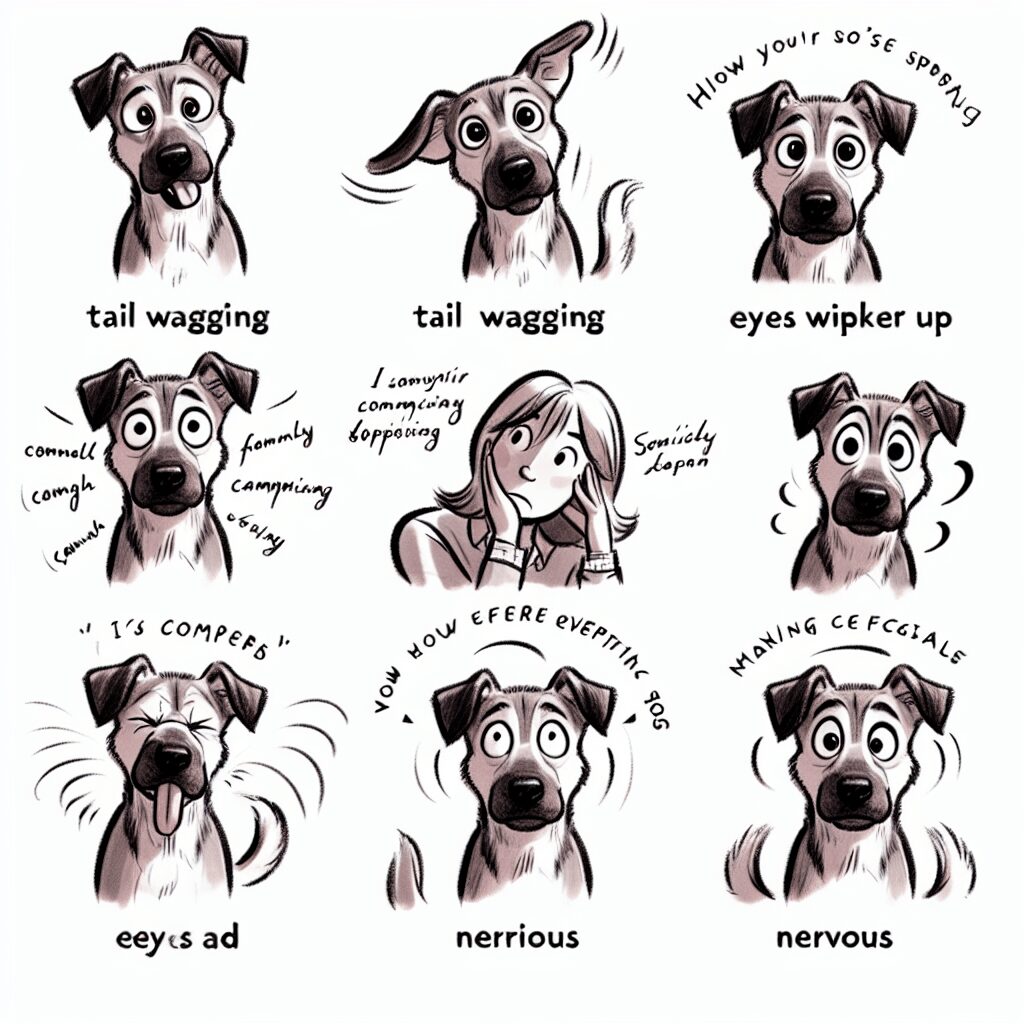Decoding Dog Speak: What Your Furry Friend Is Trying to Tell You
As a devoted dog lover, there’s nothing quite like the bond we share with our furry companions. Those wagging tails and soulful eyes speak volumes, but the dog speak lexicon goes far beyond just barks and body language. Each bark, whine, and wag signifies something unique, offering insights into your pup’s thoughts, feelings, and even health. Join me on this journey to decode the ways your dog communicates, ensuring you foster a deeper connection and understanding with your four-legged friend.
Chapter 1: Understanding the Basics of Dog Communication
Dogs are natural communicators, employing a combination of vocalizations, body language, and facial expressions to relay their messages. Let’s start by breaking down the major methods in which dogs converse with us and with each other.
-
Vocalizations: Dogs use a variety of sounds—barks, growls, yips, and howls—all of which convey different meanings. A high-pitched whine might signal excitement or anxiety, while a deep growl may indicate the dog feels threatened or protective.
-
Body Language: Dogs communicate extensively through their body posture. A relaxed body, wagging tail, and a loose mouth signal happiness, while a lowered tail and hunched shoulders may indicate fear or submission.
-
Facial Expressions: Dogs can express a range of emotions through their facial features. Raised eyebrows can indicate curiosity, while a tight-lipped smile may mean a dog is feeling threatened.
Understanding the basics of dog communication lays the foundation for interpreting your dog’s behavior and enhancing your relationship.
Chapter 2: Barking: The Sound of Emotion
1. Happy Barks
When your dog greets you with enthusiastic barks and a wagging tail, they are expressing pure joy! Happy barking is often accompanied by playful behaviors, such as jumping, spinning, and running in circles.
2. Alert Barks
What about barking to alert you to an intruder or strange noise? This type of bark is typically deep and steady. It’s your dog’s way of saying, “There’s something going on, and I am here to protect you!”
3. Lonely or Anxious Barks
A dog left alone may bark out of loneliness or anxiety, often manifesting as a series of quick, high-pitched yips. If your dog seems to bark excessively when left alone, it may be worth exploring separation anxiety solutions.
Being aware of the different types of barking can help you respond appropriately to your dog’s needs, whether it’s playtime, protection, or comfort.
Chapter 3: Whining: A Plea for Attention
Whining is one of the more nuanced forms of dog communication. It can indicate a variety of emotions. Here are a few interpretations of this often-frustrating sound:
-
Attention-Seeking Whines: If your dog is looking directly at you and whining, they likely want your attention—whether it’s for playtime or cuddles.
-
Discomfort or Pain: Persistent whining can be a sign of anxiety, discomfort, or pain. If you notice this and it’s out of character for your dog, it’s essential to consult your veterinarian.
-
Wanting to Go Outside: Dogs will often whine when they need to relieve themselves. If you’re outdoors and your dog whines, it may be time for a potty break!
Understanding your dog’s whining patterns can greatly enhance their comfort and happiness.
Chapter 4: The Tail Tells All
The tail is one of the most expressive parts of your dog’s body. It serves as a significant indicator of your dog’s emotional state:
-
Wagging Happy Tails: A fast wagging tail, especially when combined with a wagging body, indicates a very happy dog! It’s one of the clear signs that your pup is excited and ready for interaction.
-
Low, Slow Wags: A dog that wags their tail low and slowly is likely feeling submissive or unsure. This may occur when meeting new dogs or people.
-
Straight and Rigid Tails: A tail held high and still may indicate a dog that is alert, interested, or even aggressive, especially if accompanied by a hard stare.
-
Tail Tucked Between Legs: A sagging tail tucked low signifies fear or submission. If you notice this in your dog, it’s essential to provide them with comfort and security.
Each wag tells a story, and recognizing these signals can strengthen your bond with your dog.
Chapter 5: The Importance of Eye Contact
Eye contact is a profound form of communication among dogs. It can convey everything from affection to aggression.
-
Soft Eye Contact: When your dog gazes at you with soft eyes, it’s a sign of affection and trust. Take it as a cue to give them some extra pets or snuggles!
-
Hard Staring: If your dog holds a fixed stare and their body language is tense, it may be a sign of discomfort or aggression. By understanding this, you can mitigate potential conflicts.
-
Slow Blinking: Believe it or not, dogs also slow blink! If your dog looks at you and slowly closes its eyes, it’s their way of showing love and relaxation.
Eye contact is more than just a glance; it’s about trust, love, and understanding.
Chapter 6: The Significance of Playfulness
Play is one of the core ways dogs communicate their emotions. Observing how your dog interacts can tell you a lot about their mood.
-
Play Bow: A classic play bow, where a dog lowers their front end while keeping their rear end in the air, is an invitation to play! Your dog is saying, “Come on, let’s have some fun!”
-
Chase and Pounce: If your dog runs around in circles and playfully nips at you or other dogs, they’re feeling energetic and playful. It’s a perfect opportunity for some interactive playtime!
-
Toys as Communication Tools: If your pup brings you a toy and drops it at your feet, they may be inviting you to engage in play. It’s their way of saying, “Look what I found, let’s play!”
Recognizing playful behavior can not only enhance your relationship but also ensure your dog remains physically and mentally stimulated.
Chapter 7: The Language of Ears
A dog’s ears can reveal significant insights about their emotional state and intentions.
-
Erect Ears: When a dog’s ears are up and alert, they are curious and engaged. This typically occurs when they hear or see something of interest.
-
Relaxed Ears: A dog with relaxed, pendulous ears is generally feeling calm and comfortable. This is the perfect moment for some snuggles!
-
Pinned Back Ears: Ears that are pinned back against the head indicate fear or submission. If you notice this, it’s essential to offer reassurance and comfort.
Ears may seem minor, but they are key to understanding what your dog is feeling in different situations.
Chapter 8: The Art of Responding
Now that we’ve unlocked some of the secrets of dog communication, the final key is knowing how to respond to what your furry friend is sharing.
-
Positive Reinforcement: When your dog communicates with excitement or eagerness, respond positively by engaging them or offering treats. Encouraging your dog will create a loop of positive interactions.
-
Provide Comfort During Anxious Moments: If your dog is whining or showing signs of discomfort, offer your presence and comfort. A gentle pet or a soothing voice can work wonders.
-
Dodging Communication Breakdown: Be aware of your emotions and body language around your dog; they can pick up on your mood and energy, which should be a cooperative and calm response.
Understanding how to translate your dog’s communications into actions can strengthen your relationship and improve your dog’s overall well-being.
Conclusion
Decoding dog speak is not only fascinating; it’s also an essential skill for fostering a deep and meaningful bond with your canine companion. By understanding the intricate ways your dog communicates—through vocalizations, body language, eye contact, and playful gestures—you can ensure they feel heard, loved, and valued. Taking the time to become fluent in the language of dog can lead to a happier, well-adjusted pup and a closer relationship between you and your beloved furry friend.
Let’s continue to learn and grow together with our dogs, nurturing that special bond and ensuring a life of happiness, love, and understanding!
FAQs
1. How can I tell if my dog is happy?
Look for a wagging tail, relaxed body posture, playful antics, and soft eye contact. A happy dog often seeks interaction and enjoys spending time with you.
2. Why does my dog bark so much?
Barking can have different meanings, including excitement, alerting you to something, or anxiety. Observing the context and your dog’s body language will help determine the cause.
3. What does it mean when my dog avoids eye contact?
Avoiding eye contact can signify fear, submission, or discomfort. It’s essential to provide a calm and safe environment if your dog exhibits this behavior.
4. How can I encourage my dog to communicate more?
Engage in interactive play and training, reward their attempts at communication, and create an environment where your dog feels comfortable expressing their needs.
5. Is it normal for dogs to bark at strangers?
Yes, many dogs bark at strangers as a natural instinct to protect their territory. However, socialization and training can help reduce excessive barking.
6. Can dogs interpret human emotions?
Absolutely! Dogs are keen observers and can sense human emotions through body language and tone of voice. They may respond accordingly to your mood.
7. What should I do if my dog is showing aggressive body language?
If your dog displays signs of aggression, it’s best to give them space and avoid confrontation. Consult a professional dog trainer or behaviorist for guidance.
8. How can I improve my dog’s anxiety?
Provide a safe space, engage in positive reinforcement training, establish routines, and consider consulting a veterinarian about behavioral therapy options if the anxiety persists.
Unlock the Secrets to a Well-Behaved Dog! 🐾 Tired of your pup’s bad habits? Discover how to transform your unruly dog into a loving companion with our FREE Dog Training Mini Course! Learn essential commands, potty training tips, and effective techniques to eliminate unwanted behaviors in just days. Don’t miss out—sign up now and start your journey to a happier, obedient dog! Join Here! (https://bit.ly/3RJak0a)
Instantly Access Your Free Children’s Books Here! (https://payhip.com/BlueCherryStore) –
Disclaimer: As an Amazon Associate, I earn from qualifying purchases; I may earn a commission from qualifying purchases as an affiliate. Please note that I only recommend products I believe will provide value to my readers. (M)









